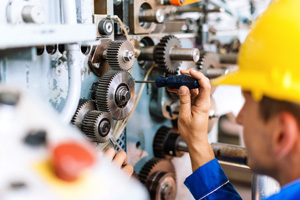An Inspection Schedule will go a Long Way
You know the importance of a scheduled maintenance for that machine that’s given you years of hard work. Making sure that you inspect every aspect of your web handling system or converting machine is critical to your operation. You might be interested to know that one rule of thumb for a machine running 24/7 should be to have a quick visual inspection once a month and a thorough inspection every six months.
In a previous preventive maintenance article, we discussed back-up batteries and how replacing them will save time and money, and ultimately a lot of headache. However, the battery isn’t the only part of a machine that can be overlooked. Here is a list of other items that should be inspected.
- Belts – like any engineer can attest, moving parts that are in constant contact with other parts will eventually wear and ultimately fail. This holds especially true for belts since they’re usually made of a rubber material for their flexibility. When conducting a visual inspection be sure to look around and below all belts, if dust particles are visible you may need to replace them sooner than later. If larger pieces are visible then the belts need replacing immediately. This could also indicate misalignment or a tension problem.
- Bearings – a lot of times you’ll hear a bearing fail before you see it. A clear scraping sound will indicate a worn out or completely failed bearing. To keep a bearing in good working order be sure to top off the grease when doing any type of inspection.
- Fasteners – during a visual inspection be sure to check all fasteners. Replace any that are loose or broken, you don’t want anything to fall off while the machine is running.
- Air Cylinders – check for faulty seals in all air cylinders. A clear indication is any escaping air when the cylinder is activated. A cylinder not working at full capacity is a safety risk.
- Wires –during a quick visual inspection, be sure that all wires look to be intact, especially on the terminal strips. When conducting a thorough inspection give each of those connections a light tug. If they come out too easily then you should fix the connector so that it is held firmly. Over time the machine’s vibration can disconnect any loose wires which could shut it down.
- Gear Boxes – gears usually need to be checked during a thorough inspection since getting to them usually takes more time. However, some boxes may be out in the open, which can be easier to inspect during a visual inspection. Check the gear teeth for wear and chipping. If you can get into a gear box you should have the ability to move the gears by hand to see if there is any significant play where one gear is moving more freely than the other. You may even hear a clear audible sound of the teeth hitting one another. This is a clear indication of a worn gear box and should be fixed or replaced immediately.
- Turret Bearings – web handling and converting machinery like a turret winder or slitter use roller bearings to support the turret disc. These roller bearings are engineered to structurally support the weight of the disc, shafts, rolls of material, and all the components. However, these could eventually fail. When doing the visual inspection check to see if there is a groove in the turret disc or if the spacing isn’t concise between the turret disc and the frame. Roller bearings should be replaced immediately if there is any indication of failure.
Shutting down your machine for just a few hours every so often for inspection will go a long way in keeping that workhorse going for decades to come.
